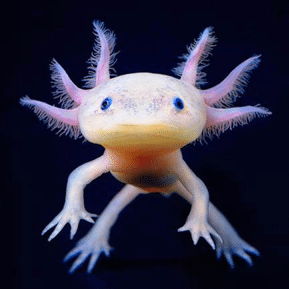 The Mexican salamander, or the axolotl, may have tiny feet, but the feat of decoding its genetic footprint was huge—32 billion base pairs huge, making it ten times bigger than the human genome and the largest ever sequenced.
The Mexican salamander, or the axolotl, may have tiny feet, but the feat of decoding its genetic footprint was huge—32 billion base pairs huge, making it ten times bigger than the human genome and the largest ever sequenced.
The accomplishment by an international team of scientists is significant, not only because of its sheer size, but also because of the insights it could provide into tissue regeneration.
The easily recognizable critter has an astounding ability to regenerate body parts, growing lost limbs – bones, muscles, nerves and all – within weeks. It can also repair spinal cord and retinal tissue, and is easy to breed, making it a popular biological model since 1864. But the size of its genome, and the number of repetitive sequences within it, has made full genetic analysis impossible – until now.
In a recent Nature paper, The axolotl genome and the evolution of key tissue formation regulators, lead authors Elly Tanaka of the Research Institute of Molecular Pathology in Vienna, Michael Hiller and Gene Myers, of the Max Planck Institute of Molecular Cell Biology and Genetics, and Siegfried Schloissnig of the Heidelberg Institute for Theoretical Studies, describe how they sequenced, assembled, annotated, and analyzed the complete Ambystoma mexicanum genome using PacBio long-read sequencing, optical mapping and a new genome assembler called MARVEL.
“We sequenced 110 million long reads (32× coverage, N50 read length 14.2 kb) using Pacific Biosciences instruments to avoid the read sampling bias that is often found when using other technologies and to span repeat-rich genomic regions that cause breaks in short-read assemblies,” the authors write.
The long reads allowed the team to overcome several assembly challenges, such as 18.6 Gb of repetitive sequences (65.6% of the contig assembly) and distinct long terminal repeat (LTR) retroelement classes and endogenous retroviruses with elements more than 10 kb long.
The researchers observed that LTR expansion is a major contributor to giant genome size in axolotl, which is consistent across animals and plants. They also isolated genes unique to axolotl and identified one crucial developmental gene that was missing (PAX3); its functions were taken over by another gene (PAX7).
The next step, the authors note, will be to apply methods such as chromatin immunoprecipitation with sequencing (ChIP–seq) or assay for transposase-accessible chromatin using sequencing (ATAC-seq) to investigate the genomic basis of gene regulation during regeneration.
“Together with methods such as CRISPR-mediated gene editing, viral expression methods, transplantation and transgenesis, the axolotl is a powerful system for studying questions such as the evolutionary basis of its remarkable regeneration ability,” they conclude.